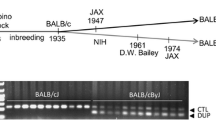Abstract
Selective breeding techniques were used to alter allelic frequencies responsible for diazepam sensitivity and resistance. We used the rotarod test to determine the duration of diazepam-induced neurologic deficit in genetically heterogeneous mice. Males were more sensitive than females in the initial population. We then selectively bred for diazepam resistance and sensitivity. A significant difference between the lines was apparent in both sexes after two generations, and divergence has continued over seven generations. Brain benzodiazepine assays indicated that absorption and distribution of diazepam do not differ in the two lines. Differences in brain benzodiazepine concentrations at recovery from ataxia indicated that the two lines differ in central nervous system sensitivity. We found diazepam-induced rotarod impairment to be blocked in a dose-dependent manner by the specific benzodiazepine antagonist Ro 15-1788, indicating that this effect is mediated through BZ receptors. A dose-response curve obtained from generations 6 and 7 indicates a 9- to 14-fold difference in dose required to obtain similar effects in the two lines. These mice are expected to be useful experimental subjects in studies of benzodiazepine mechanisms.
Similar content being viewed by others
References
Alho H, Costa E, Ferrero P, Fujimoto M, Cosenza-Murphy D, Guidotti A (1985) Diazepam-binding inhibitor: A neuropeptide located in selected neuronal populations of rat brain. Science 229:179–181
Belknap JK, Haltli NR, Goebel DM, Lame M (1983) Selective breeding for high and low levels of opiate-induced analgesia in mice. Behav Genet 13:383
Cooper SJ (1980) Benzodiazepines as appetite-enhancing compounds. Appetite 1:7–19
Cooper SJ, Barber DJ, Gilbert DB, Moores WR (1985) Benzodiazepine receptor ligands and the consumption of a highly palatable diet in non-deprived male rats. Psychopharmacology 86:348–355
Crabbe JC, Kosobud A, Young ER (1983) Genetic selection for ethanol withdrawal severity: differences in replicate mouse lines. Life Sci 33:955–962
DeFries JC (1981) Current perspectives on selective breeding: example and theory. In: McClearn GE, Deitrich RA, Erwin VG (eds) NIAAA Research Monograph 6, Superintendant of Documents, Washington, DC, pp 11–35
Duk T, Cumin R, Haefely W, Herz A (1981) Naloxone blocks the effect of diazepam and meprobamate on conflict behavior in rats. Pharmacol Biochem Behav 15:115–117
Dunham NW, Miya TS (1957) A note on a simple apparatus for detecting neurological deficit in rats and mice. J Am Pharm Assoc 46:208–209
Falconer DS (1983) Introduction to quantitative genetics, 2nd edition. Longman, London
File SE (1983) Variability in behavioral responses to benzodiazepines in the rat. Pharmacol Biochem Behav 18:303–306
File SE, Greenblatt DJ, Martin IL, Brown C (1985) Long-lasting anticonvulsant effects of diazepam in different mouse strains: Correlations with brain concentrations and receptor occupancy. Psychopharmacology 86:137–141
Gallaher EJ, Henauer SA, Jacques CJ, Hollister LE (1986) Benzodiazepine dependence in mice following ingestion of drug-containing food pellets. J Pharmacol Exp Ther 237:462–467
Goldstein DB (1973) Inherited differences in intensity of alcohol withdrawal reactions in mice. Nature 245:154–156
Hamon M, Soubrie P (1983) Review: Searching for endogenous ligand(s) of central benzodiazepine receptors. Neurochem Int 5:663–672
Henauer SA, Gallaher EJ, Hollister LE (1984) Long-lasting single-dose tolerance to neurologic deficits induced by diazepam. Psychopharmacology 82:161–163
Hill WG (1972) Estimation of realised heritabilities from selection experiments. I. Divergent selection. Biometrics 28:747–765
Hunkeler W, Mohler H, Pieri L, Polc P, Bonetti EP, Cumin R, Schaffner R, Haefely W (1981) Selective antagonists of benzodiazepines. Nature 290:514–516
Judson BA, Goldstein A (1978) Genetic control of opiate-induced locomotor activity in mice. J Pharmacol Exp Ther 206:56–60
Koblin DD, Dong DE, Deady JE, Eger EI (1980) Selective breeding alters murine resistance to nitrous oxide without alteration in synaptic membrane lipid composition. Anesthesiology 52:401–407
Krogsgaard-Larsen P, Arnt J (1980) Pharmacological studies of interactions between benzodiazepines and GABA receptors. Brain Res Bull 5:867–872
Li T-K, Lumeng L, McBride WJ, Waller MB (1981) Indiana selection studies on alcohol-related behaviors. In: McClearn GE, Deitrich RA, Erwin VG (eds) NIAAA Research Monograph No. 6, Superintendant of Documents, Washington, DC, pp 171–191
Lippa AS, Klepner CA, Benson DI, Critchett DJ, Sano MC, Beer B (1980) The role of GABA in mediating the anticonvulsant properties of benzodiazepines. Brain Res Bull 5:861–865
McClearn GE, Kakihana R (1981) Selective breeding for ethanol sensitivity: short-sleep and long-sleep mice. In: McClearn GE, Deitrich RA, Erwin VG (eds) NIAAA Research Monograph No 6, Superintendant of Documents, Washington, DC, pp 147–159
McClearn GE, Wilson JR, Meredith W (1970) The use of isogenic and heterogenic mouse stocks in behavioral research. In: Contributions to behavior — genetic analysis — the mouse as a prototype. Appleton-Century-Crofts, New York, pp 3–22
Mohler H, Okada T (1977) Benzodiazepine receptor: Demonstration in the central nervous system. Science 198:849–851
Parry HJ, Balter LB, Mellinger GD, Cissin IH, Manheimer DI (1973) National patterns of psychotherapeutic drug use. Arch Gen Psychiatry 28:769–783
Pellow S (1985) Can drug effects on anxiety and convulsions be separated? Neurosci Biobehav Rev 9:55–74
Riley EP, Freed EX, Lester E (1976) Selective breeding of rats for differences in reactivity to alcohol. An approach to an animal model of alcoholism: I. General procedures. J Stud Alc 37:1535–1547
Roberts RC (1981) Current perspectives on selective breeding: theoretical aspects. In: McClearn GE, Deitrich RA, Erwin VG (eds) NIAAA Research Monograph No 6, Superintendant of Documents, Washington, DC, pp 37–58
Sanger DJ (1985) Minireview: GABA and the behavioral effects of anxiolytic drugs. Life Sci 36:1503–1514
Seppinwall J, Cook L (1980) Relationship of GABA to antianxiety effects of benzodiazepines. Brain Res Bull 5:839–848
Squires R, Braestrup C (1977) Benzodiazepine receptors in rat brain. Nature 266:732–734
Tallman JF (1980) Interactions between GABA and benzodiazepines. Brain Res Bull 5:829–832
Tallman JF, Gallager DW (1985) The GABA-ergic system: A locus of benzodiazepine action. Annu Rev Neurosci 8:21–44
Wilson JR, Erwin VG, DeFries JC, Petersen DR, Cole-Harding S (1984) Ethanol dependence in mice: Direct and correlated responses to selection. Behav Genet 14:235–256
Author information
Authors and Affiliations
Additional information
Permanent address: VA Medical Center (151P) Portland OR 97207 USA
Rights and permissions
About this article
Cite this article
Gallaher, E.J., Hollister, L.E., Gionet, S.E. et al. Mouse lines selected for genetic differences in diazepam sensitivity. Psychopharmacology 93, 25–30 (1987). https://doi.org/10.1007/BF02439582
Received:
Revised:
Issue Date:
DOI: https://doi.org/10.1007/BF02439582




